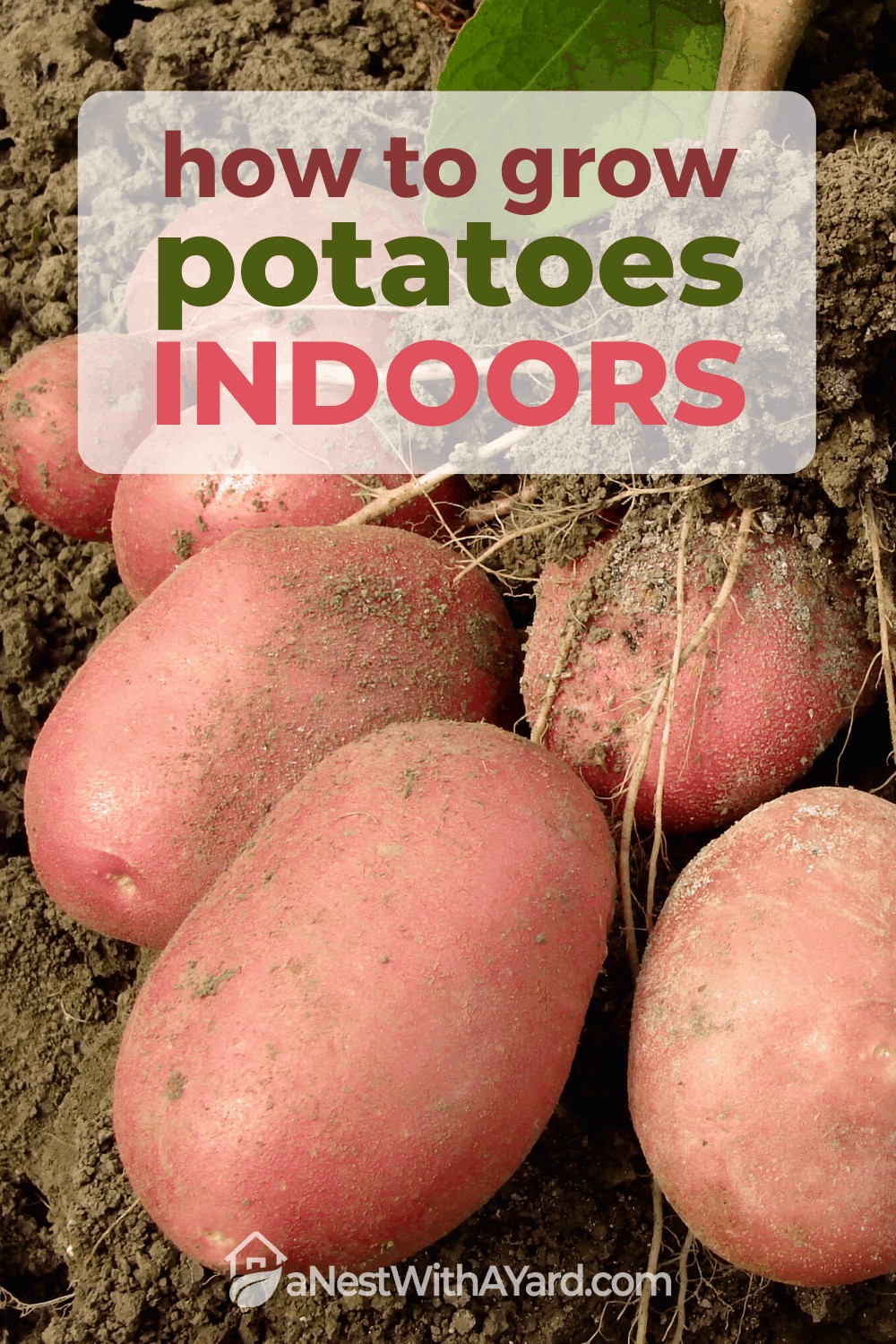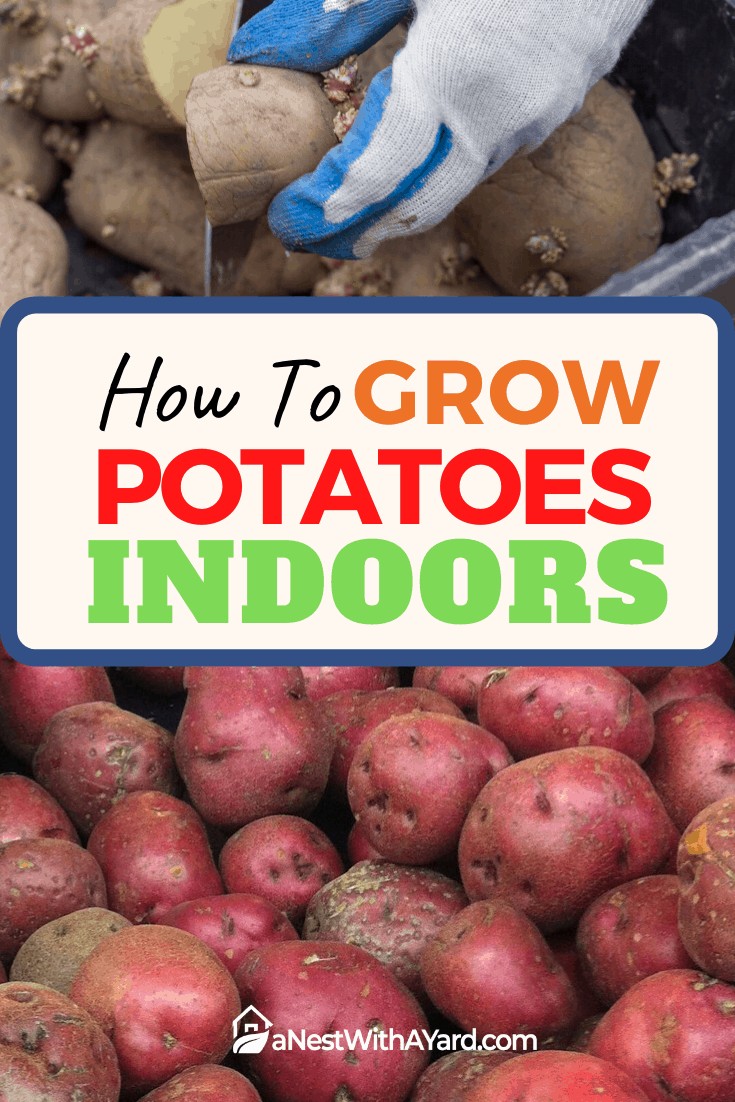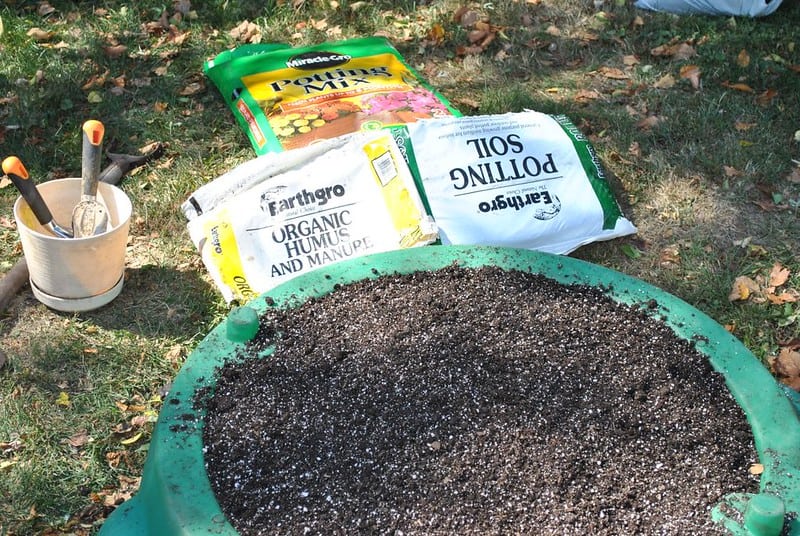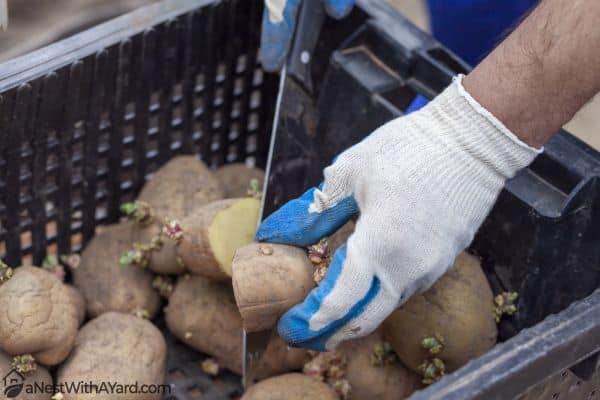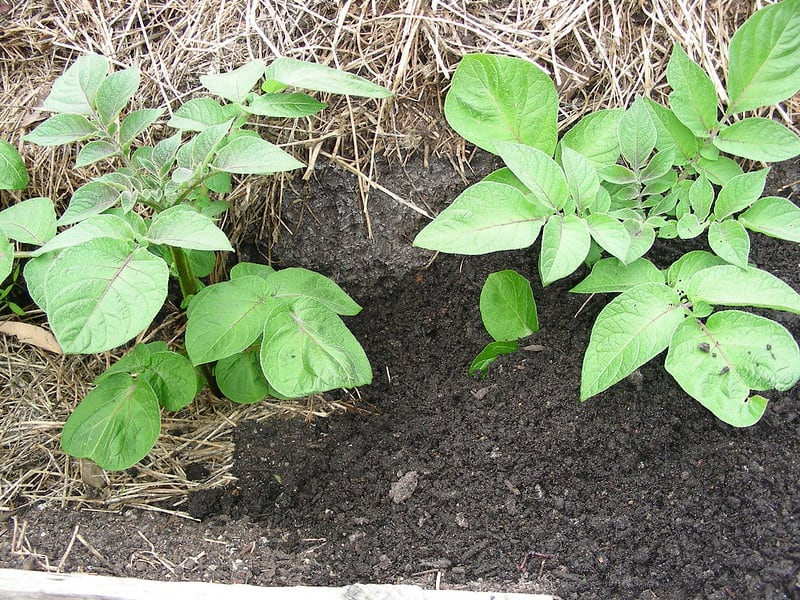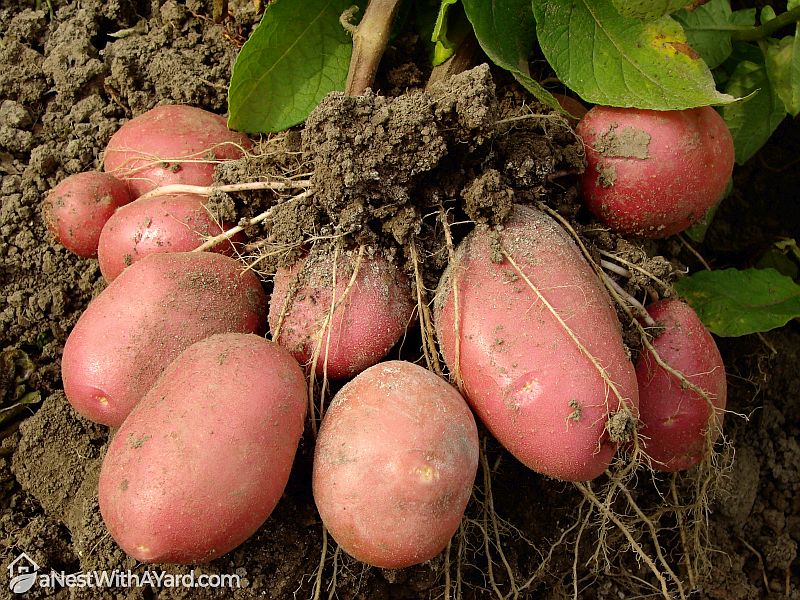Simply put, to grow potatoes indoors, find a container that’s 16 inches wide and tall. Leave your seed potatoes by a window until they grow sprouts. Add 6 inches of potting mix to your container, place the potatoes on top, and cover them with another 6 inches of potting mix. Water regularly.
Wondering how to grow potatoes indoors? You’re in the right place.
I love gardening for pleasure and self-sufficiency, which is why I wrote this article. Potatoes combine the best of both worlds: not only are they a delicious and versatile superfood, but they’re easy to grow and have beautiful foliage.
Additionally, they’re extremely space-efficient for a crop in the same food group as corn, wheat, and rice. One potato plant can produce 10 potatoes in one square foot (based on the square foot gardening method).
Compare this to corn, which can only produce about two ears in the same amount of space. This means that an apartment-dweller can grow the nutritional equivalent of a cornfield!
Even if you have a yard, gardening indoors lets you grow food in the winter. Want to harvest fresh, organic spuds like these in your own home? Keep reading to learn how.
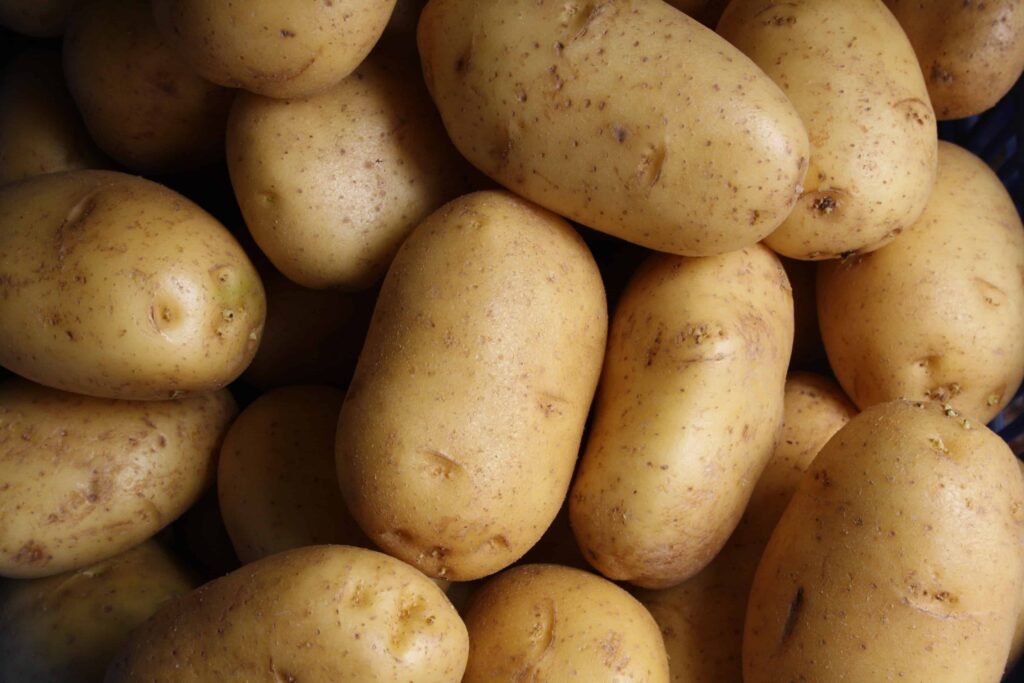
Contents
Here’s What You’ll Need:
An asterisk next to an item means I’ll discuss this more below.
- A container that’s at least 16 inches wide and deep
- Seed potatoes *
- Potting mix
- A sunny window
- Organic fertilizer pellets *
- Composted manure *
Seed Potatoes Vs Grocery Store Potatoes
For the highest-quality potatoes, your best bet is to buy seed potatoes from a seed company. Potatoes from seed companies are bred and selected to produce healthy plants, and many have been tested for diseases.
Additionally, seed companies sell fascinating potato varieties that aren’t typically in grocery stores. I’m partial to a purple strain called Adirondack Blue, which has a unique nutty flavor.
Grocery store potatoes haven’t been tested for diseases or created for gardeners. However, it’s convenient and thrifty to use potatoes from your kitchen.
If you accidentally buy diseased grocery store potatoes, you can at least contain the disease by keeping the contaminated potting mix away from your yard.
If you decide to get your seed potatoes from a grocery store, choose some that were grown organically. Non-organic potatoes are chemically treated to keep them from sprouting.
Organic Vs Synthetic Fertilizer
Whether you should use organic or synthetic fertilizer is up to you. The main reason to choose organic fertilizer (such as composted manure) is that it’s better for the environment.
Unlike organic fertilizer, synthetic fertilizer works immediately and releases nutrients steadily. However, it does nothing to support soil health and can even kill beneficial soil microbes.
How To Grow Potatoes Indoors
Here is a step-by-step guide on how to grow potatoes indoors:
- Find A Good Container
The size of your container will affect the size and quantity of the potatoes you grow.
For the best results, find a container that’s at least 16 inches (41 centimeters) tall and wide. If it doesn’t already have drainage holes, be sure to create some. Place a tray under the pot to collect drainage water. - Get (Or Make) Potting Mix
For container gardening, potting mix is better than potting soil because it doesn’t get compacted. Unfortunately, it’s usually more expensive.
image credit: flickr.com
A 16-inch container needs 20 quarts (18.93 liters) of potting mix, so you may prefer to save money by making your own.
You can make your own potting soil by following this recipe:
• 10 quarts (9.46 liters) peat moss
• 5 quarts (4.73 liters) perlite
• 5 quarts vermiculite
• 5 quarts composted manure
• 2 cups (.47 liters) sand
• 2 cups time-release fertilizer pellets
• ½ cup (118.29 milliliters) lime
Simply mix these ingredients, and you’re done. In case you’re wondering, the lime is meant to counteract the acidity of the peat moss. - Get Some Seed Potatoes
Some potato varieties take as few as nine weeks to mature, whereas others take more than 16. Either way, you should plant a variety that will make the wait worth it.
As I explained earlier, you can get seed potatoes from a seed company or from a grocery store. The only advantages of getting them from a grocery store are price and convenience. Seed companies have interesting varieties that you can’t find in a produce section. - Chit The Potatoes
To chit, a potato is to encourage it to sprout. Doing so makes it more likely that you’ll have a good harvest.
image credit: flickr.com
To chit a potato, you will need:
• A potato with eyes
• A sunny window
• A small container to hold the potato in place
Follow these steps:
Look For An Eye
The eyes on a potato each have the potential to grow a new plant. Look for the largest eye on a potato, or better yet, one that has already sprouted.
Put The Potato In A Container
Facing the best eye upward, place the potato in a small container to hold it in place. An egg carton or empty fruit cup will work.
Place The Container In A Sunny Location
Place the container in a sunny area, such as a windowsill. Leave it there for a few days or weeks until the potato grows one or more large sprouts. - Cut Your Chitted Potatoes Into Small Pieces (If Necessary)
If your seed potatoes are 2 inches (5.08 centimeters) or smaller in diameter, you can skip this step. Otherwise, cut each potato into approximately 2-inch pieces with a sprout or two on each.
Give the cut pieces two to three days to heal before you plant them. - Add Fertilizer Before Planting
Fill your container with 6 inches (15 centimeters) of potting mix. Then, mix in fertilizer pellets (Grow A Good Life recommends Plant-tone) at the ratio suggested on the packaging. - Plant The Potatoes
Place your seed potatoes six inches apart on top of the potting mix.
You’ll probably be able to fit four-to-six potatoes. Then, cover them with an additional six inches of potting mix and water thoroughly.
Leave the container in a window that gets at least six hours of sunlight daily. - Water Regularly
It’s important to keep the potting mix moist. How often you should water it will depend on how well it holds moisture, as well as the temperature and humidity of its growing environment.
You can tell if your potting mix needs water by sticking your finger in it up to your knuckles. If the potting mix feels dry on your fingertip, it’s time to water it thoroughly. - Add Composted Cow Manure
When you see stems and leaves emerge from the potting mix, it’s time to add more fertilizer. A simple way to keep the plants well-fed is to surround them with a top-dressing of composted cow manure.
Apply it as though it were mulch. Nutrients will wash deeper into the potting mix every time you water it. - As The Plants Grow, Add More Soil
When the potato plants are 6 inches tall, add about 3 inches (7.62 centimeters) of potting mix to the container. It’s called “hilling”.
image credit: flickr.com
Sprinkle on a thin layer of cow manure. Repeat this process every two weeks until the container is full. - Stop Watering After The Leaves Turn Yellow
Your potatoes will be done growing when their leaves turn yellow. At this point, you should stop watering the potting mix and let the foliage die. Leaving the potatoes alone during this process will help them toughen up for long storage life. - Harvest Your Potatoes
When the foliage is dead, you can probably harvest your potatoes. Harvest one and make sure its skin doesn’t rub off easily. If it does, eat that potato soon and wait a few more days to harvest the others.
To avoid making a mess, have a trashcan nearby to scoop the potting mix into. Don’t rinse the potatoes, as this will interfere with the curing process. Clean them by gently rubbing them with a dry towel.
If any potatoes look lightly injured, eat them as soon as possible. They won’t store well. If they look diseased or severely injured, toss them out. - Cure Them For Storage
When you cure potatoes, you coax them into slowing their respiration and thickening their skins. This lets them hibernate through several months in storage.
image credit: homesteaderdepot.com
Cure your potatoes by laying them on newspapers or regular paper in a cool (50F-60F/10C-15.56C), well-ventilated, and darkroom for two weeks.
It’s extremely important to protect potatoes from light, as it can make them turn green. Green potatoes can be high in solanine, a toxin that can cause symptoms ranging from mildly unpleasant to fatal. - Store Them Properly
In general, you should store your potatoes in a well-ventilated container, such as a perforated cardboard box. Cover it with newspaper to keep it dark inside.
Store the container in a cool, darkroom. Temperatures from 42F to 50F (5.56C to 10C) are ideal, but potatoes can handle warmer temperatures for a shorter amount of time. Keep an eye on them so you can use them up before they spoil.
How you should store your potatoes depends on how you intend to prepare them. If you’re looking forward to hashbrowns, beware that potatoes stored in cold temperatures turn dark when fried. This isn’t dangerous but may look unappetizing.
FAQs
When To Stop Watering Potatoes?
You should stop watering potatoes either two weeks before harvesting them or when their vines turn yellow and die.
When To Stop Watering Potatoes?
You should stop watering potatoes either two weeks before harvesting them or when their vines turn yellow and die.
Now You Know How To Grow Potatoes Indoors!
I hope my article has inspired you to try this project! You can’t go wrong with learning how to grow potatoes indoors because they’re a nutritious starchy vegetable, easy to grow, space-efficient, and have beautiful foliage.
It’s also nice to be able to grow hearty and versatile food year-round, even in winter.
Indoor gardening is also good for your mood and health, as I’ve explained in this article. It improves air quality, relieves stress, and can even boost your productivity. Plus, certain crops give you food or medicine.
For more indoor gardening ideas, click here.
And if you want to grow more plants but have little space, you should look into the Garden Tower 2. It can grow 50 plants in 4 square feet (0.37 square meters). I’m not sure how well it can grow potatoes, but it can definitely grow sweet potatoes!
Have you enjoyed this tutorial? If you have, please share it with like-minded friends! And if you have any thoughts or concerns you’d like to share, please do so in the comments.
